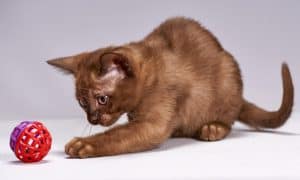Appearance
The Burmese is a strong, athletic and elegant short haired cat that carry surprising weight for its size and has often been described as “brick wrapped in silk.”
It has a fine, close, even, and glossy coat . Their coats are very short, satin-like in texture, and generally require little grooming other than daily petting. At maturity males are large, the females are more delicate and graceful, and the difference in weight between them may be two or three pounds.

The Burmese is a compactly built cat with a small round head and wide-set eyes which are yellow or golden. A Burmese’s tail is tapered. The European Burmese is an elegant yet not-so-fragile cat. It is medium-sized, has good bone structure and muscular development and has very expressive eyes. The major difference between these breeds is the colours:
Burmese Colours
The Burmese cat has ten main recognised colours in Australia, the United Kingdom and Europe:
- Brown – the original Burmese colour, a rich, warm seal brown.
- Blue – a soft blue-grey with a silver sheen.
- Chocolate – warm milk chocolate.
- Lilac – a pale, delicate dove grey with a pinkish cast.
- Red – The fur colour is red-orange on the torso and melon-orange on the outer coat.
- Cream – cream with a distinct bloom on the head and back, giving a powdered effect.
- Brown tortie – brown with shades of red.
- Blue tortie – Blue with shades of cream.
- Chocolate tortie – Chocolate with shades of red.
- Lilac tortie – lilac with shades of cream.
In America, many cat associations recognise the four main colours of Burmese cats. Those colour variations also have alternative names compared to those described above:
- Sable, the same as ‘Brown’
- Champagne, the same as ‘Chocolate’
- Platinum, the same a ‘Lilac’
- Blue, the same as ‘Blue’
Only a few organisations recognise the remaining colours. In many American associations, additional colours and certain other physical features characterise the European (or “Foreign”) Burmese.
Personality
The Burmese is an amiable inquisitive cat with an outgoing, loving nature – this is why Burmese is one of the most popular breeds.
It has been said that the Burmese are more like dogs than cats in their behaviour. For example, when encouraged from kittenhood, they will fetch. They will greet you at the door when you come home and comfort you when you are ill or unhappy – they give unconditional love.
The Burmese is an upfront cat, not left out of where it is all happening. It’s a participator – alert, curious, intelligent, interfering and gregarious: you cannot ignore it! The Burmese thinks you are offering him a warm and comfortable bed when you sit down. When you kneel to weed the garden, the Burmese will use your back as a vantage point to observe the environment. When you do your daily chores in the house, the Burmese will assume that your shoulder is the best place where tasks can be assisted.
The Burmese like to explore the environment. Anything that is mechanical and moves makes a good game for the Burmese. They understand door handles very quickly, and the owners often have to fit door levers upside down. Height is not a deterrent. Very muscular, the Burmese love to jump on the tops of doors and surprise unwary visitors.
Nevertheless, Burmese do settle down as they grow out of adolescence, and they can be trained by saying NO! kindly and firmly. Still, you need to start early and may need to persist because the Burmese are very strong-minded, and they effortlessly rule their families.
Living Needs
Even though the Burmese is an ideal breed for families, children and older people – for those who want a less interactive pet that will spend all its time in relaxation, the Burmese is not the right choice.
Also, the social nature of the Burmese does mean that they need company – humans and felines. Toys cannot replace this company. Therefore it is essential that, when the owner is at work, buy two Burmese kittens, ideally from the same litter. That way, the stress of moving is halved, and the cats’ temperament is much more relaxed and loving in the long run.
On the other hand, if they are left in the home alone, they will want to play all night and disturb the owner’s sleep. Also, they will find something to occupy their time.
Unfortunately, what they consider fun we call destructive. This principle applies to all cats, but the more intelligent, social and active breeds, such as Burmese, must have company. A happy Burmese is a blessing to the home; an unhappy one can disrupt the household.
Breed History
Burmese cats lived for centuries in Burma, Thailand and Malaya. In the late 1800s, they were known in England as Chocolate Siamese, but because they were not favoured, they gradually died out in England and Europe. The ancestry of Burmese cats can be traced back to one cat named Wong Mau, a brown female from Burma who arrived in San Francisco in the early 1930s to Dr Joseph Thompson.
The Burmese were established as a distinct breed through selective breeding of Siamese. Lighter-coloured kittens were occasionally produced, and eventually, the American breeders requested cognition from CFA for these “dilute” colours; first, as another breed named Malayan, then later as a dilute division of Burmese.




